This book review for Hazel Everett’s Goldwork & Silk Shading Inspired by Nature published at the end of last year is long overdue!
And since I’ve had a little timing and scheduling glitch going on with the Bee-Jeweled Pincushion project (more on that, on Friday!), today is a perfect day to fit it in.
If you’ve not seen this book yet, now’s a great time to take a look at it and see if it’s right for you. It’s a combination technique-and-project book that covers a wide range of goldwork, shading, and some other embroidery techniques, and condenses them into an equally wide range of projects, from simple to complex. I think it’s a good book for beginners and beyond, and you’ll certainly find some excellent gems of instruction and inspiration within!

Goldwork & Silk Shading Inspired by Nature is Hazel Everett’s second book on goldwork. The first, Goldwork Techniques, Projects, and Pure Inspiration, I reviewed here.
Sadly, Hazel passed away in 2018. She had already begun Goldwork & Silk Shading, and her husband and a friend collaborated to finish it.
The book is a fine tribute to her embroidery knowledge and skills.

Many of the projects within the book are quite sumptuous! And there are many projects within the book. As I started through it, I was pleasantly surprised to find that there was much more within the pages of this book than I originally expected.
The book provides a good exploration of goldwork (with its materials and techniques), plus a study in silk shading, plus exploration in combining the two.
We are presented with projects that can stand alone as goldwork, or as silk shading, or as a composite of both.
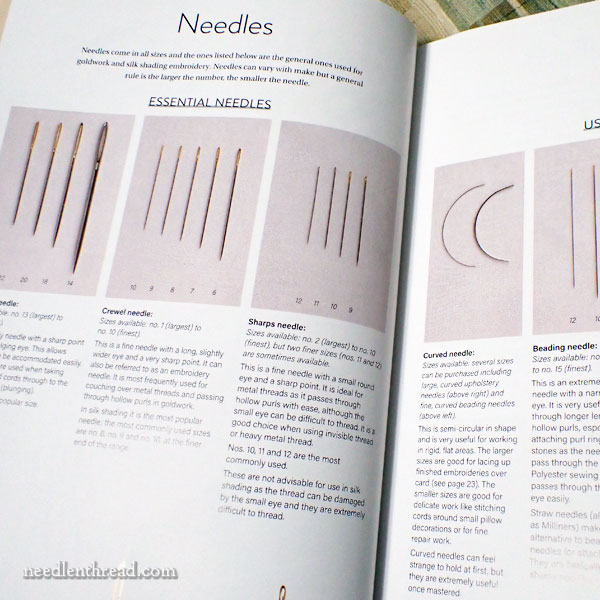
At the beginning of the book, you’ll find all kinds of introductory information.
While some of the instructional information here – especially on materials – is repeated from her first book, it is necessary! There’s nothing worse than sitting down with a project book and finding out you have to go find another book to get the preliminary information. I’m glad that the publishers did not assume that the reader would have both books on hand.

You’ll find instructions on how to dress a slate frame, which is the embroidery frame favored by many – and especially the Royal School of Needlework, where Hazel attended – for goldwork and other forms of embroidery.

She covers several methods for transferring designs to fabric…
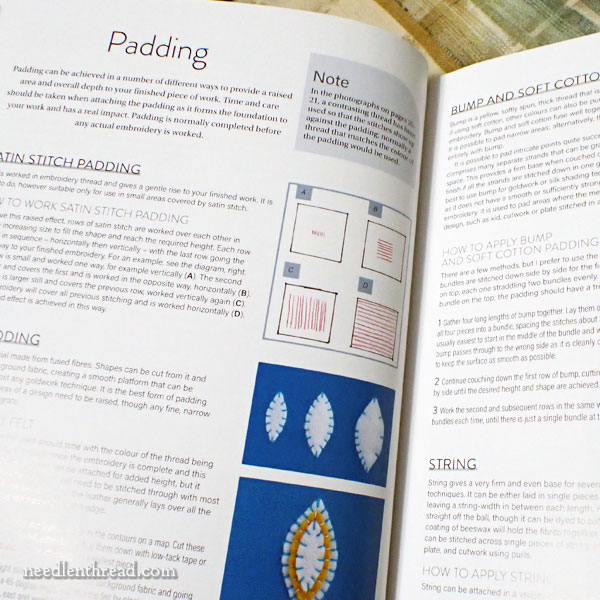
… and then things get specific to goldwork, with instructions on padding…

… and a thorough exposé on the different types of real metal threads used for goldwork.
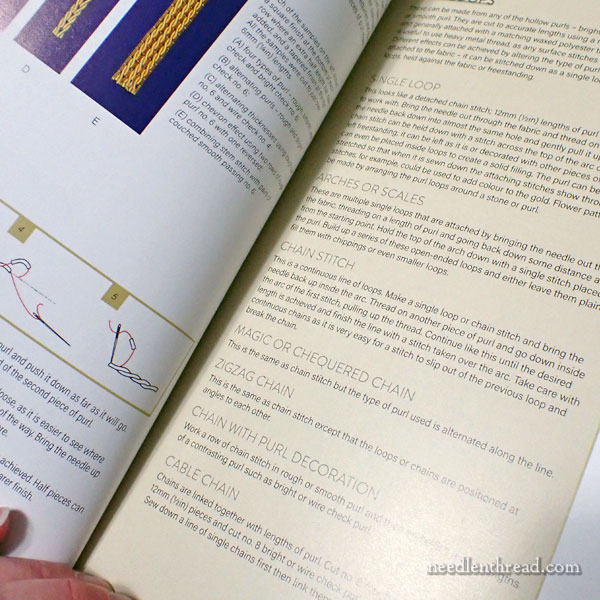
Then, she launches into goldwork instruction, by examining the various techniques that are used when working with the different types of goldwork threads.
In this section, you’ll learn everything you need to know, in order to work the goldwork and combination projects later in the book.
Think of this part of the book as a reference section. As you work the projects, you’ll refer to this section for techniques.
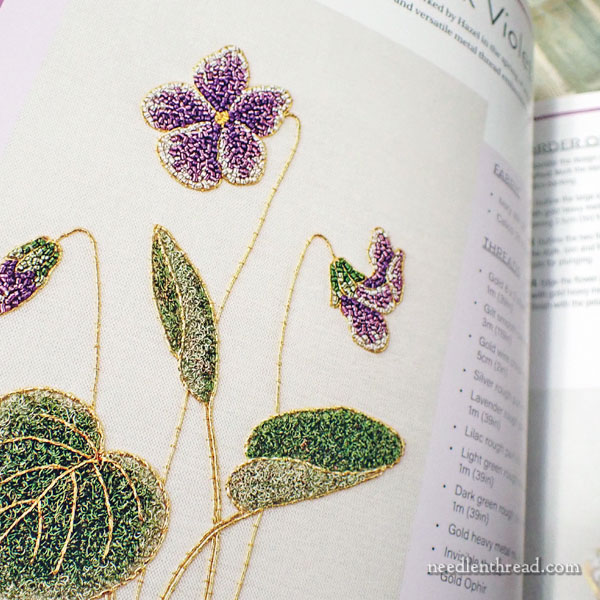
Then, at the end of this section, you’ll find three small projects presented for goldwork: a wild rose, violets, and a 3D Christmas rose.
These three projects will show up again, at the end of the next section on silk shading.
For each project, you’ll find a materials list and the techniques used to complete the project.
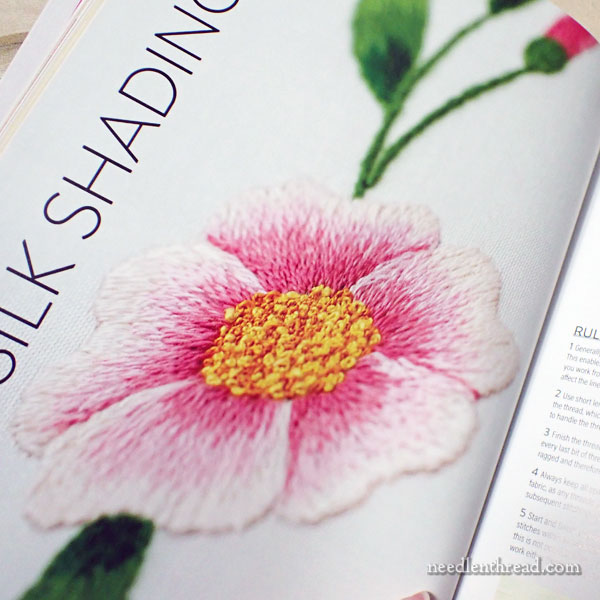
Next, we move into the section on silk shading.
Before getting into the projects, the author talks about materials and techniques.

Then, she moves into the three projects – the wild rose, the violet, and the 3D Christmas rose – all stitched in silk shading techniques.

Following this section, we move into combining goldwork and silk shading, exploring the same projects, with different nuances, worked in both techniques together.
From here, the book branches out into other complementary techniques and other projects in goldwork and silk shading.

All of the projects include materials, techniques, and the order of work, so that you can recreate them on your own.
Some of the projects are more of a study or sampler in techniques…

…like this flower sampler…

…or this simple flower design, demonstrated several different ways.

For the fungi lovers out there, there are even mushrooms!

Finally, at the end of the book, we get four seasonal projects.
One, of course, is the vivid and exuberant clematis featured on the cover of the book.

There’s a fabulous autumn sampler. What a great choice of ground fabric! The brown silk dupioni provides such an autumnal, woodsy setting.

The final pages of the book are devoted to line drawings of all the designs used, for easy tracing or copying before transferring to fabric.
Pros and Cons
Pros: It’s a very accessible instructional and project book, with a wide variety of projects for practicing and perfecting techniques. You can go from very simple to much more complex projects, and learn much from this book! For beginners or seasoned stitchers, you’ll find loads of inspiration. You might even find some great ideas for techniques you never thought to use in certain ways. There many little pleasant surprises and discoveries throughout the book.
It’s a great book for reference, but it’s also wonderful for projects and further explorations.
Cons: Not many! Any con that I found mostly lies in personal preference for techniques, materials, and the like – which just goes to show you that there is no One-Way-Only in embroidery!
Where to Find It
Gosh, if you’re in the US, lucky you! There’s a special discount on the book right now. You can find it here on my Amazon Recommendations Page, under Browse My Amazon Recommendations book section. I’ve moved it up to the first slot for you. I don’t know how long that special will run, but the book is just under $22.
Worldwide, you can find the book here through Book Depository.
This article contains affiliate links to book sources, which means that Needle ‘n Thread receives a small commission for any purchases made through those links at no extra expense to you. Thanks!







It looks lovely. Even the projects looks less project-y (which is a plus in my view, though I know I’m in a minority). I’m not a big fan of gold, but I believe ‘goldwork’ is really a misnomer and includes working with other metals, such as silver.
Is it possible to work with metal threads without using animal products? I’m less concerned about beeswax, but I really want to avoid silk. I realise you can use different ground fabric, but what about the couching thread? Or can you just not hope to achieve equivalent results without silk threads?
Yes, you can absolutely avoid silk in metal thread embroidery. In fact, in the goldwork classes I’ve taken with the Royal School of Needlework (RSN) they used Gutermann polyester sewing thread for couching down metal threads such as pearl purl. In another non-RSN class the teacher actually recommended that we not use silk for the couching threads because she said that the polyester sewing thread was much stronger. Personally, I like using silk, but I respect the desire to avoid using animal products. When couching down threads such as pearl purl the stitching should be invisible, so using non-silk threads makes no difference in the appearance of the final product.
As for visible couching, such as brick stitching rows of passing thread, I’ve used cotton floss and silk. Either will work, but the appearance will be different. Frankly, once you wax the silk threads they become much duller and lose some of their lustre. They become more cotton-like in appearance.
Ultimately, as with all aspects of embroidery, use what works for you. There are no rules, only guidelines, recommendations, and best practices. There are no embroidery police!
There are also places you can buy synthetic silk from. I’m going to try some embroidery soon with synthetic silk I bought from Vietnam (on Etsy I believe).
So you can use that if you like the look of silk!